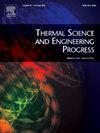考虑施工水化热效应的高温隧道非线性传热机理研究
IF 5.4
3区 工程技术
Q2 ENERGY & FUELS
引用次数: 0
摘要
针对高温隧道衬砌结构易受支护时机和水化热耦合影响而产生的温度致裂问题,采用有限差分法建立了在建隧道径向温度场的瞬态数值计算模型。重点分析支护参数和环境因素对衬砌温度场的影响,以优化隧道衬砌的热管理,防止温度引起的结构问题。研究结果表明:(1)水化热对衬砌内部温度分布有显著影响,导致衬砌内外表面温差最大达到51.52℃。(2)在标准衬砌结构中,环境温度与二次衬砌内部最大温差和外表面稳定温度均呈线性关系。回风速度通过指数关系影响这些温度指标,其特征是向上和向下的凸曲线。同样,初始支护和二次衬砌施工之间的时间间隔与这些温度指标呈指数相关,呈现向下的凸曲线。(3)对于三明治式衬砌结构,保温层厚度对最大温差和稳定表面温度的影响呈指数关系,分别呈向上和向下的凸曲线模式。本文章由计算机程序翻译,如有差异,请以英文原文为准。
Investigation of nonlinear heat transfer mechanisms in high geotemperature tunnels considering construction hydration heat effects
To address the problem of temperature-induced cracks in high-temperature tunnel lining structures, which are susceptible to the coupling effects of support timing and hydration heat, this study establishes a transient numerical calculation model of the radial temperature field for tunnels under construction using the finite difference method. The primary focus is to analyze the influence of support parameters and environmental factors on the lining temperature field, with the goal of optimizing thermal management of tunnel linings to prevent temperature-induced structural issues. The main conclusions are as follows: (1) Hydration heat has a pronounced impact on the temperature distribution within tunnel linings, leading to a maximum temperature variance of 51.52 °C between the interior and exterior surfaces. (2) In standard lining structures, ambient temperature is linearly related to both the Maximum temperature difference within the secondary lining and the stabilized temperature at the outer surface. Return air velocity influences these temperature metrics through exponential relationships, characterized by upward and downward convex curves. Similarly, the time interval between the construction of initial support and secondary lining shows an exponential correlation with these temperature metrics, exhibiting downward convex curves. (3) For sandwich-type lining structures, the thickness of the insulation layer impacts the Maximum temperature difference and stabilized surface temperature through exponential relationships, resulting in upward and downward convex curve patterns, respectively.
求助全文
通过发布文献求助,成功后即可免费获取论文全文。
去求助
来源期刊

Thermal Science and Engineering Progress
Chemical Engineering-Fluid Flow and Transfer Processes
CiteScore
7.20
自引率
10.40%
发文量
327
审稿时长
41 days
期刊介绍:
Thermal Science and Engineering Progress (TSEP) publishes original, high-quality research articles that span activities ranging from fundamental scientific research and discussion of the more controversial thermodynamic theories, to developments in thermal engineering that are in many instances examples of the way scientists and engineers are addressing the challenges facing a growing population – smart cities and global warming – maximising thermodynamic efficiencies and minimising all heat losses. It is intended that these will be of current relevance and interest to industry, academia and other practitioners. It is evident that many specialised journals in thermal and, to some extent, in fluid disciplines tend to focus on topics that can be classified as fundamental in nature, or are ‘applied’ and near-market. Thermal Science and Engineering Progress will bridge the gap between these two areas, allowing authors to make an easy choice, should they or a journal editor feel that their papers are ‘out of scope’ when considering other journals. The range of topics covered by Thermal Science and Engineering Progress addresses the rapid rate of development being made in thermal transfer processes as they affect traditional fields, and important growth in the topical research areas of aerospace, thermal biological and medical systems, electronics and nano-technologies, renewable energy systems, food production (including agriculture), and the need to minimise man-made thermal impacts on climate change. Review articles on appropriate topics for TSEP are encouraged, although until TSEP is fully established, these will be limited in number. Before submitting such articles, please contact one of the Editors, or a member of the Editorial Advisory Board with an outline of your proposal and your expertise in the area of your review.
 求助内容:
求助内容: 应助结果提醒方式:
应助结果提醒方式:


